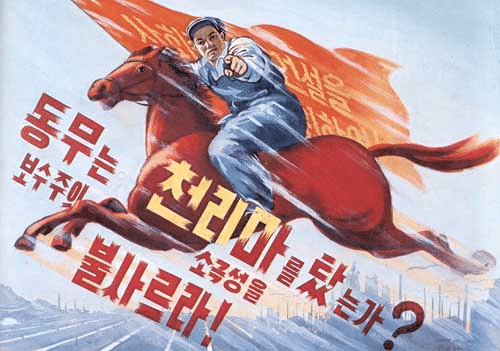Among present scholars of North Korea, there has been a tendency to throw the baby out with the bathwater in regards to labels like “socialism” or “communism” in favor of terms like “fascism” or “race-based nationalism,” even to the point of suggesting that North Korea was never really a communist country at all. While there may be a good case for doing this, this tendency obscures the fact that there were times in North Korea history when socialist-oriented discourse was the norm. The most notable such period was the Flying Horse Movement, or what North Korea has come to refer to as the Age of the Chollima.
The Chollima, literally the “Thousand Li Horse” came from a wide range of pre-modern Chinese texts featuring a horse that could travel a long distance in a short period of time. It was first used in North Korea as a rallying cry to motivate North Korean workers and ended up as a potent symbol for North Korea’s proposed path towards industrialization and prosperity. Other than the anti-Japanese struggle of Kim Il Sung and his fellow guerilla fighters, it is probably the most monumental period in North Korean history to North Koreans.
Among present scholars of North Korea, there has been a tendency to throw the baby out with the bathwater in regards to labels like “socialism” or “communism” in favor of terms like “fascism” or “race-based nationalism,” even to the point of suggesting that North Korea was never really a communist country at all. While there may be a good case for doing this, this tendency obscures the fact that there were times in North Korea history when socialist-oriented discourse was the norm. The most notable such period was the Flying Horse Movement, or what North Korea has come to refer to as the Age of the Chollima.
The Chollima, literally the “Thousand Li Horse” came from a wide range of pre-modern Chinese texts featuring a horse that could travel a long distance in a short period of time. It was first used in North Korea as a rallying cry to motivate North Korean workers and ended up as a potent symbol for North Korea’s proposed path towards industrialization and prosperity. Other than the anti-Japanese struggle of Kim Il Sung and his fellow guerilla fighters, it is probably the most monumental period in North Korean history to North Koreans.
Become a member for less
than $5.75 per week.
Unlimited access to all of NK News: reporting, investigations, analysis
The NK News Daily Update, an email newsletter to keep you in the loop
Searchable archive of all content, photo galleries, special columns
Contact NK News reporters with tips or requests for reporting
Get unlimited access to all NK News content, including original reporting, investigations, and analyses by our team of DPRK experts.
Subscribe now
All major cards accepted. No commitments – you can cancel any time.













